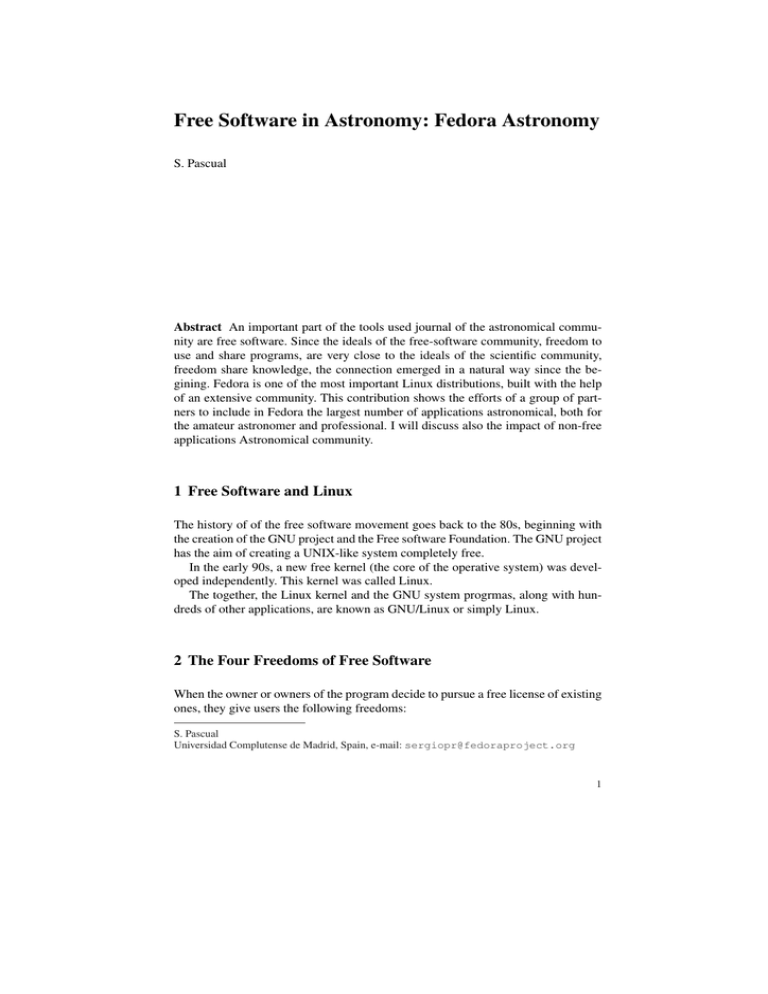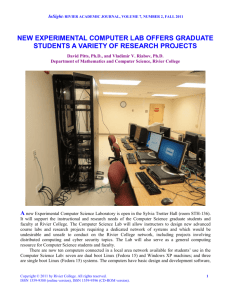Free Software in Astronomy: Fedora Astronomy
advertisement

Free Software in Astronomy: Fedora Astronomy S. Pascual Abstract An important part of the tools used journal of the astronomical community are free software. Since the ideals of the free-software community, freedom to use and share programs, are very close to the ideals of the scientific community, freedom share knowledge, the connection emerged in a natural way since the begining. Fedora is one of the most important Linux distributions, built with the help of an extensive community. This contribution shows the efforts of a group of partners to include in Fedora the largest number of applications astronomical, both for the amateur astronomer and professional. I will discuss also the impact of non-free applications Astronomical community. 1 Free Software and Linux The history of of the free software movement goes back to the 80s, beginning with the creation of the GNU project and the Free software Foundation. The GNU project has the aim of creating a UNIX-like system completely free. In the early 90s, a new free kernel (the core of the operative system) was developed independently. This kernel was called Linux. The together, the Linux kernel and the GNU system progrmas, along with hundreds of other applications, are known as GNU/Linux or simply Linux. 2 The Four Freedoms of Free Software When the owner or owners of the program decide to pursue a free license of existing ones, they give users the following freedoms: S. Pascual Universidad Complutense de Madrid, Spain, e-mail: sergiopr@fedoraproject.org 1 2 S. Pascual • Freedom 0: The freedom to run the program for any purpose (private, educational, commercial, military, public. . . ). • Freedom 1: The freedom to study and modify the program (source code of the program is required). • Freedom 2: The freedom to copy the program so you can help your neighbor. • Freedom 3: The freedom to improve the program, and release your improvements to the public, so that the whole community benefits (source code of the program is required). 3 Science and Free Software Since the ideals of the free-software community, freedom to use and share programs, are very close to the ideals of the scientific community, freedom share knowledge, the connection emerged in a natural way since the begining. The first steps of free software were at universities and research laboratories. Many free software developers work for corporations, other developers create free tools as a response to problems encountered during their research activities. Tools made free benefit others and in turn developers benefit from the contributions of users of the tool. 4 Free Software and Astronomy A large fraction of the tools used by professional astronomers in their research are free, but otherw are non-free but gratis, meaning that they can be used free of charge. 4.1 Non-free software tools used in Astronomy Non-free software violates some of the previous freedoms. For example (the list is non exhaustive): • Privative software: Matlab, IDL, supermongo. . . • Restrict redistribution (non-commercial, educational only, and so on.) Pgplot, Aladin, voplot. . . • They depend on non-free code: IRAF, REDUCEME. . . 4.2 Free software tools used in Astronomy • Gnuplot, Octave, R Free Software in Astronomy: Fedora Astronomy • • • • • 3 LaTex, emacs, vi GNU compiler collection: gcc, g++, gfortran, g77, ada. . . Programming languages such as:Perl, Python, Ruby, Java. . . Processing tools: Midas, Starlink Visualization tools: ds9, gaia 5 What is Fedora? Fedora is a Linux-based operating system that includes the latest in free software and open source. Fedora is always free for anyone to use, modify or distribute. It is built by people around the world who work together as a community: the Fedora Project. The Fedora project emerged in 2003 following the withdrawal of RHL, the commercial version of Linux RedHat Fedora is used by RedHat as a base for its commercial product Red Hat Enterprise Linux. About 20 LInux distributions use Fedora and RHEL as a base (CentOS, Scientific Linux, Aurora SPARC, Yellow Dog, etc.). 6 The Fedora Astronomy Group A group of people interested in astronomy, collaborating in the project Fedora, decided to create a group to work with the following objectives: • Furnish, within Fedora, the maximum amount of astronomical and astrophysical software . • Create a version of Fedora as a Live CD, allowing amateur astronomers to control the largest possible amount of instrumentation, with only a computer with the boot disk Fedora Astronomy. At the moment there are about thirty astronomical packages in Fedora, including: • • • • • DS9, XPA, wcstools Sextractor, swarp Cloudy Cfistio, CCfits Pyfits, Numdisplay More programs are expected to be included in Fedora soon: Midas, PyMidas, Wcslib. . . . 7 How to help? • Using free tools 4 S. Pascual • Suggesting new tools that can be included in Fedora • Testing the operation of existing applications and send bug reports to those that do not work • Entering the project Fedora: http://fedoraproject.org/en/join-fedora Addresses of Interest: • Fedora Project: http://fedoraproject.org/ • Group Astronomy: http://fedoraproject.org/wiki/SIGs/Astronomy • Listing programs, including, rejected, pending inclusion: http://fedoraproject. org/wiki/SIGs/Astronomy#Packages Acknowledgements S. Pascual acknowledges the support of the postdoctoral grant under the the Spanish Plan Nacional de Astronomı́a y Astrofı́sica AYA2006-15698-C02 project.


